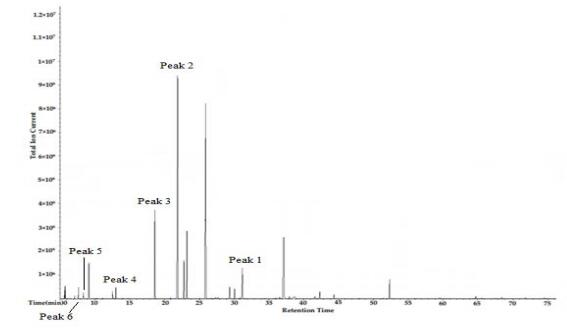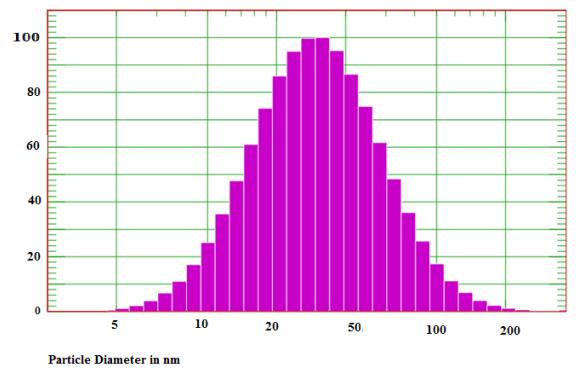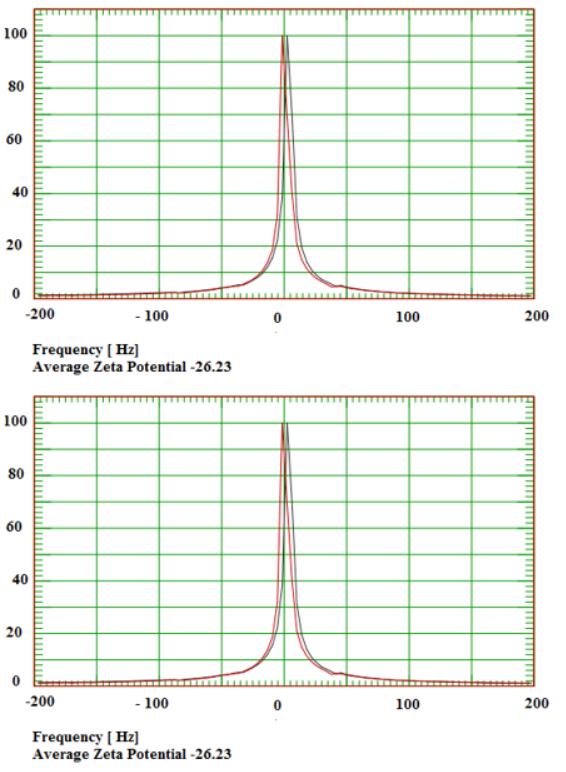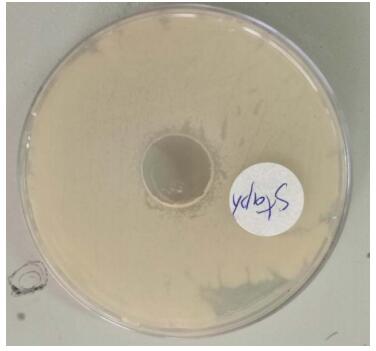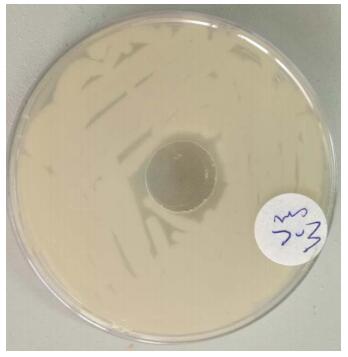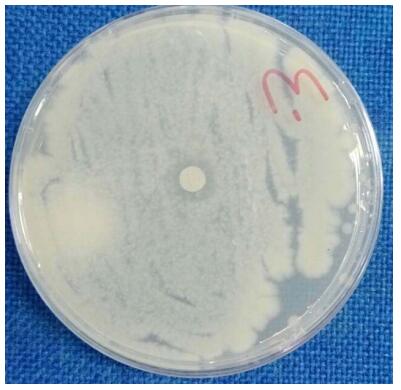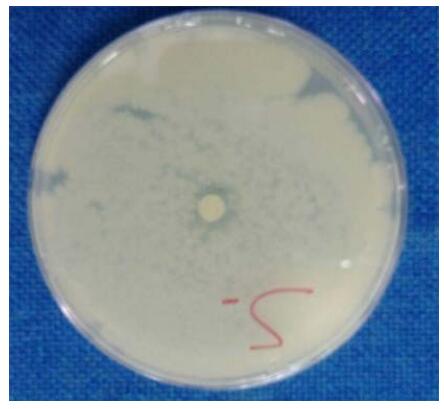Garlic oils have promising possibilities for a wide range of applications in the food and pharmaceutical industries. Their widespread utilization is limited as they are lipophilic and highly volatile. Furthermore, they also possess strong odor and low physicochemical stability. Therefore, the present study aims to investigate the characteristics of garlic oil nano-emulsion through investigating its antibacterial activity. The emulsion was prepared and the size distribution and zeta potential of the nanoparticles were investigated using a Nicomp Z3000 particle size analyzer. S. aureus and E. coli specimens were impregnated with garlic oil and garlic oil nano-emulsions. The results indicated that the mean particle diameter was 36.3 nm, polydispersity index was 0.527, and average zeta potential was −26.23 mV. Garlic oil nano-emulsion was more effective against S. aureus than E. coli. Moreover, the antibacterial activity of garlic oil nano-emulsion was lower than regular garlic oil. The study concluded that modifications are to be made with respect to particle size, concentration, and zeta potential.
1.
Introduction
The use of essential oils has historically been noted in a wide variety of aromatherapy and medicinal applications [1]. These oils can be extracted from plants and are found to be highly volatile [2], transparent, and lipid soluble liquids [3]. Additionally, the solubility of essential oils is demonstrated in organic solvents (benzene, methanol, toluene, acetone, etc.) that have less density as compared to water. Recent literature targeting essential oils have consistently remarked upon their anti-bacterial [4], anti-inflammatory [5], anti-carcinogenic [6], and anti-diabetic properties [7]. For these reasons, these essential oils are found to be highly relevant in a range of real-world applications, corresponding to the food and drug industries.
Garlic plant is broadly utilized for food flavoring and widely hailed to have a positive impact on human health well-being, based on its characteristic organo-sulfur mixes [8]. Garlic oil predominantly contains diallyl disulfide, diallyl trisulfide, allyl propyldisulfide, disulfide, and probablydiallyl polysulfide [9]. Specifically, essential oils extracted from garlic (Allium sativum L) are found to present with advantageous anti-carcinogenic, anti-diabetic, and anti-microbial activity, which is found to be significant for a host of medicinal and pharmacologic applications [10]. Furthermore, they are capable of decreasing the cholesterol and blood pressure levels, and possess the ability to reduce plasma agammaegation [11].
The utilization of garlic oil is limited due to its high volatility, strong odor, water insolubility, and low physicochemical stability [12]. Following oral administration, the bioavailability of garlic oil decreases with respect to systemic circulation based on its earlier mentioned factors. Therefore, its application in food, cosmetic, and drug industries is greatly limited, despite of many advantageous properties posed through the use of garlic oil. For this reason, it has been recommended to adopt the use of nano-scale garlic oil micro emulsions for improving their industrial applications, through dropping their needed levels of dosage [13]. This may be carried out through the use of lipid-based formulations to improve the oral bioavailability and dissolvability of water-soluble medications such as garlic oil.
The use of nanotechnology in this context is highly significant due to its ability to manipulate, characterize or fabricate materials or devices, which have dimensions of around 1 to 100 nm [14]. Nano-emulsions are typically possessing dimension below 500 nm and have enhanced assimilation properties achieved through the use of mucosa [15]. It demonstrates a high level of stability in suspension and is produced through the use of high-energy or low-energy methods due to their highly reduced dimensions [16]. Generally, high-energy methods including high pressure homogenization, micro fluidization, sonication, method in jet disperser, high-amplitude ultrasonic methods are used for producing nano-emulsions [17]. Whereas, the low-energy methods include; solvent displacement method, phase inversion methods, and spontaneous emulsification.
There is a lack of extensive research specifically pertaining to nano-scale garlic oil emulsification and their relevant properties. For this reason, this study aims to create nano-emulsified garlic oil and investigate its antibacterial properties by contrasting its functionality with regular garlic oil.
2.
Materials and methods
The study incorporated the use of hydro-distillation techniques to extract garlic oil from the garlic bulb, using a Clevenger type apparatus. The materials incorporated in this research were tween-80 (CDH, New Delhi 110002, and India) and propylene glycol (CDH, New Delhi 110002, and India). The developed formulation was kept at room temperature for six months and no phase separation was detected to maintain stability.
2.1. Preparation of garlic oil nano-emulsion
Shimadzu GCMS-QP2010 Ultra (Shimadzu Scientific Instruments, Columbia, MD, USA) was used for GC-MS characterization of garlic oils. This instrument was operated in the electron impact (EI) mode set at electron energy 70 eV [18], with scan rate of 3.0 scans per second and GC-MS solution software. Tween-80 was utilized as a surfactant whereas propylene glycol was used as a co-surfactant, for preparing the garlic oil nano-emulsion. Blends of surfactant /co-surfactant were mixed in glass test tubes fixed with caps using a vortex at predetermined mass ratios of 1:1, 2:1, and 3:1, respectively. Garlic oil was added to different mixtures of the prepared surfactant/co-surfactant, having a ratio of 1:9, 2:8, 3:7, 4:6, 5:5, 6:4, 7:3, 8:2, 9:1 (oil: surfactant/co-surfactant). Following this, ultra-pure water was added on a drop-wise basis as per the specified weights of oils: S/CoS mixtures, until a clear and transparent nano-emulsion was formed (Figure 1).
Methylene blue and Sudan Ⅲ was used for ascertaining whether the nano-emulsion was oil-in-water (O/W) or water-in-oil (W/O). The nano-emulsion was considered as W/O when Sudan Ⅲ, an oil-soluble dye, diffused quicker than methylene blue when infused in the Nano-emulsion. Conversely, the nano-emulsion was considered as O/W when methylene blue, a water-soluble dye, scattered quicker in the nano-emulsion. The best formulation for nano-emulsion was found to bear a ratio of surfactant: cosurfactant equal 3:1 and a ratio of garlic oil: surfactant and cosurfactant mixture equal to 1:9. The retention indices were determined using the n-alkanes homologous series [19].
2.2. Dynamic light scattering analysis
Dynamic light scattering analysis was used to determine the hydrodynamic size of various nanoparticles. These nanoparticles dealt with rare earth, coatings, food science, materials, pharmaceuticals, and fluorescent powders [20]. The size distribution of the nanoemulsion droplets was measured using a Nicomp Z3000 particle size analyzer (Particle Sizing Systems) (USA) for sizing. Additionally, the zeta potential of these droplets was measured using the same equipment. The samples were diluted and analyzed in triplicate. The best formulation with high transparency was chosen for characterization and kept for further investigation.
2.3. Determination of IC50 values
The study followed a standard operating procedure for culturing and harvesting cells to set the cytotoxicity assay protocols. The IC50 concentration was measured based on the density of the stock culture of cells used to set up an assay.
2.4. Antibacterial activity test
The bacterial culture present in the form of bacterial reference strains was maintained at 37 ℃ on Luria-Bertani (LB) agar and was reactivated by the subculture prior to testing. Five well-isolated colonies were removed with a sterile wire loop and inoculated into a tube containing 10 mL of LB broth and incubated at 37 ℃ for 24 hours to assess the antibacterial action. The optical density of the 24 hour-old culture of the strain was determined spectrophotometrically at 660 nm and standardized immediately prior to using an OD 660 nm of 0.068 (approximately 108 CFU/mL) using a sterile LB broth. A sum of 100 μL bacterial culture suspension was evenly spread on agar using a glass rod spreader.
The plates were dried for 10 minutes to permit the drying of the agar surface. Sterile filters papers with diameter of 6mm were impregnated with garlic oil and garlic oil nano-emulsion and placed on the culture medium. Each plate was incubated at 37 ℃ for 48 hours. The diameter of the clear zone around the disc was measured and expressed in millimeters as its antimicrobial activity and the test was run in triplicate. The slides combined with lemongrass, oregano, or cinnamon are capable of reducing growth of pathogenic bacteria (e.g., E. coli), which help in depicting better antimicrobial activity [21].
3.
Results
This study was conducted to explore the characterization of the garlic oil nano-emulsion. The GC-MS analysis using the Clevenger hydro distillation has been exhibited in Table 1. The prime components as per the Clevenger hydro distillation include diallyl disulfide (20.9%), diallyl trisulfide (allitridin) (32.9%), allyl (E)-1-propenyl disulfide (5.3%), allyl methyl disulfide (4.3%), and allyl methyl trisulfide (18.9%). Figure 2 has shown the prime components extracted from Clevenger-type laboratory distillation of garlic essential oil.
Figure 3 has shown the measurements of nanoparticles dimensions. The mean diameter of these particles was found to be 36.3 nm. Furthermore, it was observed that the coefficient of variation was 0.726, the polydispersity index was 0.527, and the average zeta potential was −26.23 mV (Figure 3).
Moreover, the type of nanoemulsion was indicated through the impacts of methylene blue and Sudan Ⅲ on the surface of the developed formulation. It was seen that methylene blue dusted on the formulation's surface demonstrated a faster rate of scattering as compared to that demonstrated by Sudan Ⅲ. Therefore, it was inferred that the external phase was water and the type of nanoemulsion was o/w.
The inhibition activity of the garlic oil on S. aureus has been indicated in Figure 5. As seen in Figure 5, the inhibition zone against E. coli had a diameter of 20 mm. Furthermore, the inhibition activity as demonstrated by the garlic oil on E. coli has been illustrated in Figure 6. However, it was additionally seen that the inhibition zone against S. Aureus was 40 mm.
Furthermore, the inhibition activity of the garlic oil nano-emulsion was investigated, which showed that the garlic oil nano-emulsion against E. coli was 10 mm (Figure 7). Whereas, the inhibition zone of the garlic oil nano-emulsion against S. Aureus was 12 mm (Figure 8). This clarifies that the garlic oil nano-emulsion demonstrates a higher level of effectiveness against S. aureus as compared to against E. coli. Moreover, it was observed that the formulated garlic oil nano-emulsion demonstrated a lower level of antibacterial activity as compared to pure garlic oil.
4.
Discussions
The present study has investigated the anti-bacterial activity of garlic oil nano-emulsions and contrast it with the anti-bacterial activity observed for regular garlic oil. The attained composition of the A. sativum essential oil has also been reported by Douiri et al [22]. Using the same hydro distillation, the obtained value was higher for diallyl trisulfide (46.5%), following the values of diallyl disulfide, allyl methyl trisulfide, and diallyl disulfide i.e., (16.0%), (10.9%), and (7.2%), respectively. These properties highlight the presence of significant compound of sulfur in garlic. Earlier studies have reported the the antifungal, antibacterial, antiviral, and antiparasitic properties of these compounds [23,24]. Moreover, the compounds such as diallyl trisulfide and diallyl disulfide are reported to possess antimicrobial activity [18].
The results show that the mean diameter of the nano-emulsion particles was 36.3 nm having a coefficient of variation equal to 0.726. It may be seen that the size of these nano-emulsion particles is significantly lower than the size observed in a study by Wencui, Qi, Ying, & Di [25]. The aforementioned study specified that the ideal size of solid lipid garlic nanoparticles in suspension were between 106.5 ± 40.3 nm and 152.3 ± 52.5 nm. Size is an important determinant of nanoparticle performance; therefore, this provides explanation of why the garlic oil nano-emulsion demonstrated lower anti-bacterial activity as compared to the garlic oil.
Furthermore, the polydispersity index was found to be 0.527. It was observed that this polydispersity index was found higher than that seen in a study by Wu, Luo and Wang [26]. The aforementioned study demonstrated a polydispersity index of 0.3 and remarked that a relatively low index corresponded well to measurement using a dynamic light scattering (DLS) instrument. Therefore, the present study has suggested that the polydispersity index of the garlic oil nano-emulsion is to be reduced accordingly. Additionally, the average zeta potential was −26.23 mV. This was found to be much higher than the average zeta potential observed by Acevedo-Fani et al. [27] for essential oil nano-emulsions. The zeta potential depends not only on the nanocarriers, but also on the medium-pH and ionic strength. The increase in ionic strength could easily reduce the absolute value of zeta potential as it has significant impact on pH associated with dissociation of acids/bases and surface composition of the nanocarrier.
Specifically, the study observed that the average zeta potential was between −41 mV and −70 m mv, based on the kind of essential oil being investigated. Bilia et al [3] specified that positive zeta potentials were significantly associated with nano-delivery system uptake over the mucosa. According to the present study, it is suggested to formulate garlic oil nano-emulsion having a positive zeta potential rather than negative. Additionally, it was seen that the type of nano-emulsion was o/w instead of being w/o. The use of o/w nano-emulsions had previously been noted in recent literature pertaining to this context [28,29,30].
The antibacterial activity of the garlic oil nano-emulsion was greater towards S. aureus bacteria as compared to E. coli. A reason for this may be attributed to the lesser sensitivity of gram-negative bacteria towards garlic oil inhibition, as compared to gram-positive bacteria. S. aureus is a gram-positive bacteria and showed a higher sensitivity to inhibition activity as compared to gram-negative bacteria [31]. Furthermore, the antimicrobial activity of the obtained microemulsions was less, as the concentration of garlic oil was less in the micro-emulsion. This outcome is similar to that reported by Zheng, Li, Wang, & Liu [32], who found that garlic micro emulsion showed strong antibacterial activity against S. aureus at higher concentration.
The application of garlic oil is limited in food and drugs, despite their unique properties. The oil possesses high volatility and unpleasant odor due to low water solubility. A study similar to the present study formulated a nanoemulsion containing essential oil for covering and protecting its volatile compounds [29]. The measurement of encapsulation efficiency of formulated nanoemulsions through gas chromatography showed an intensification of free radical scavenging capacity of nanoemulsion during their storage. The results also depicted the strong impact of garlic oil and formulated nanoemulsions against Gram-positive bacterium (S. aureus) than Gram-negative bacterium (E. coli).
5.
Conclusion
The present study has investigated the characteristics of garlic oil nano-emulsion particles. The in vitro antibacterial activity analysis of this Nano-emulsion demonstrated higher effectiveness against S. aureus than E. coli. Moreover, the formulated nano-emulsion has exhibited lower antibacterial activity than pure oil. These outcomes demonstrated that the nanoscale reduction of droplet size alone will not be sufficient to improve the antibacterial activity of the nanoemulsion modifications in an in vitro test. Rather, changes are to be made with respect to the average zeta potential, polydispersity index, and the concentration of particles within the nano-emulsion. Further studies catering to these variables need to be conducted for a larger variety of gram-positive and gram-negative bacteria.
Acknowledgements
The authors gratefully acknowledge the approval and support of this research study by the grant No. 7284-PHM-2017-1-8-F from the deanship of scientific research at Northern Border University, Arar, KSA.
Conflict of Interest
The authors declare no conflict of interest.










 DownLoad:
DownLoad:
